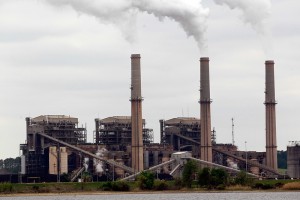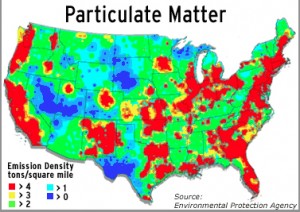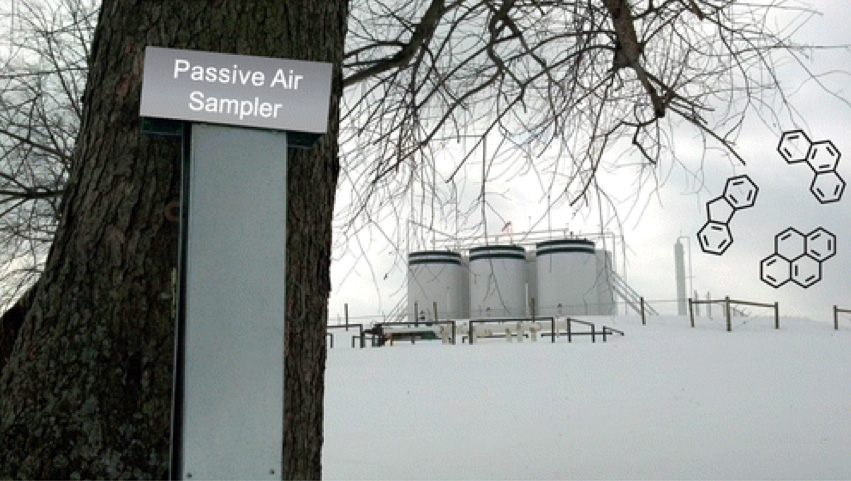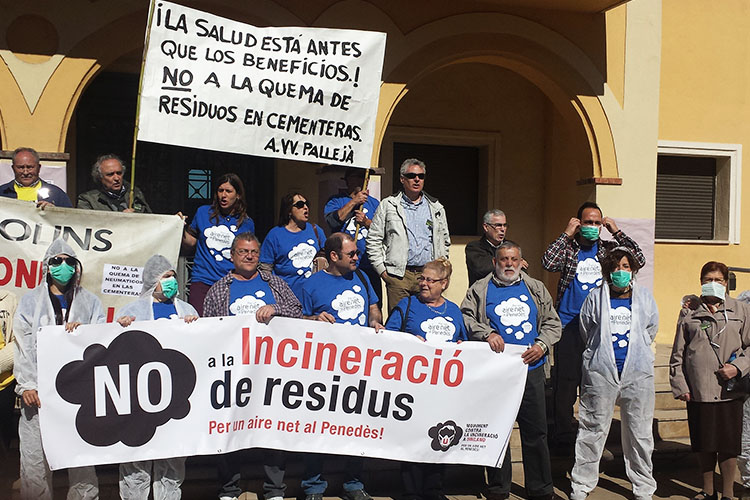air toxics
Expect Obama’s New CO2 Plan to Close Those Nasty East Texas Coal Plants? Don’t.
 By this point, most of you will have been inundated with opinions and factoids about what President Obama's new "Clean Power Plan" will and won't do about climate change. Bottom Line: while it sets a precedent and an emissions floor for the largest sources of CO2, it does so in a way which turns out to be not so challenging for most states – including Kentucky deep in Coal County.
By this point, most of you will have been inundated with opinions and factoids about what President Obama's new "Clean Power Plan" will and won't do about climate change. Bottom Line: while it sets a precedent and an emissions floor for the largest sources of CO2, it does so in a way which turns out to be not so challenging for most states – including Kentucky deep in Coal County.
That's also true for Texas, where besides being Ground Zero for the fracking boom, we also have plenty of wind power and some solar. According to the EPA, the state must cut an annual average of 51 million tons of carbon to reach its target, a reduction of about 21 percent from 2012 emissions. We're well on our way to achieving most of that reduction with current or planned wind, gas, hydro, and solar. (In what might be a first concession that natural gas shouldn't be a long-term "bridge fuel," some analysts think tweaks performed by EPA prior to the Plan's release give more incentives to adopt real renewables earlier rather than leaning on gas in the interim.)
This is mostly good news. We want the wind and solar economies to grow. The trade-off is that, under Obama's Clean Power Plan, the rise of these technologies and their emissions reductions lets the obsolete East Texas coal plants off the hook because you don't need them to close to meet your CO2-cutting goals.
Five of those obsolete coal-fired power plants surround DFW's eastern side in a half circle (Big Brown, Martin Lake, Monticello, Limestone, and Welsh). They are, without a doubt, the worst examples of fossil fuel-generated pollution in Texas. They're huge emitters of Mercury, Particulate Matter (PM), Sulfur Dioxide (SOx), and Nitrogen Oxides (NOx).
These five East Texas coal plants are projected by the state to still be releasing 150 tons a day of smog-forming NOx pollution in 2018. Because of wind direction and volume, that pollution has a very large impact on DFW air quality – probably more than any other single phenomenon. We need those coal plants to either modernize or close ASAP to help solve our chronic smog problem. But from the initial survey of the policy, the Clean Power Plan is not going to force that outcome.
While the Plan probably signals the end of any new coal plants any time soon, or at least none without CO2 solutions like sequestration or capture, the fate of existing coal plants, especially in a state like Texas, is more ambiguous. More likely, they'll continue to linger on, beneficiaries of friendly state-created policies designed to nullify the requirements of the Clean Air Act, like loosening their PM limits by magnitudes.
Now, you might think that a federal goal that's been mostly accomplished without doing anything new would be a no brainer in Austin, but there are increasingly fewer and fewer brains in Austin. Because the state's environmental agencies are now completely ideologically driven, common sense just isn't a factor anymore. Instead of asking "how can we best solve this problem?" the response is now to deny there's a problem at all and go about ginning up anti-federal hyperbole to better position yourself in the Republican Primary.
Consequently, the Texas Commission on Environmental Quality is seriously considering not turning in a required state plan of how to get the reductions needed by the deadline of 2030. If the state doesn't submit one of its own, then the EPA would write one for them. This has the business community in Texas a little nervous, since they have a lot more influence here than in DC. But citizens, which kind of anti-climate change plan would you rather have Texas abide by – one written by a state agency that denies climate change is happening and is doing everything it can to obstruct policies to prevent it, or one written by a federal agency that's actually acknowledging the obvious and doing something about it?
Regardless of whose plan does what by when, the East Texas coal plants look to be able to ride this federal policy out thanks to an almost two-decade homegrown drive to open up the state to renewables. If we want these coal plants to stop causing problems for us, we're probably going to have to find other leverage points.
One of these leverage points is demanding the state of Texas follow the law and require the coal plants install modern Selective Catalytic Reduction controls as part of the new DFW clean air plan it submitted to EPA this summer for approval. SCR could reduce smog pollution from these plants by 90%. So far, Texas has refused to even acknowledge the need to do so. EPA has requested the state change its mind – without success.
If it wants to, EPA can reject the state's plan for not including these new controls on the coal plants. But we have to encourage them to do so – by petition, and by e-mail.
Consider the five East Texas coal plants the energy sector equivalent of the obsolete "wet" kilns in Midlothian that burned hazardous waste for 20 years. They're technological dinosaurs, on their last legs, but still churning out tons and tons of harmful air pollution as they plod their way to the bone yard. The Clean Power Plan insures they'll be the last of their kind, but it's not a silver bullet.
Study: PM Pollution is an “Environmental Neurotoxin” to Brain
 It was just two months ago we featured the results of a study out of Boston that linked exposure to Particulate Matter, or PM pollution to brain aging and increased risk of dementia. Before that, we highlighted studies linking PM to autism and Parkinson-like symptoms. Now comes one more long-term, peer-reviewed report that connects ambient levels of the pollution to accelerated brain aging.
It was just two months ago we featured the results of a study out of Boston that linked exposure to Particulate Matter, or PM pollution to brain aging and increased risk of dementia. Before that, we highlighted studies linking PM to autism and Parkinson-like symptoms. Now comes one more long-term, peer-reviewed report that connects ambient levels of the pollution to accelerated brain aging.
This one is from the University of Southern California and looked at over 1,400 women without dementia who were initially enrolled in a large health study from 1996 to 1998. Researchers measured their brain volume with M.R.I. scans in 2005 and 2006, when the women were 71 to 89 years old.
Using residential histories and air pollution monitoring data, they estimated their exposure to PM air pollution from 1999 to 2006. For each increase of 3.49 micrograms per cubic centimeter (μg/m3) cumulative exposure to PM, there was an associated 6.23 cubic centimeter reduction in the subject's brain white matter, the equivalent of one to two years of brain aging. The current EPA standard for 24 PM exposure is 35 μg/m3, while the annual average standard is 12 μg/m3, although many leading scientists now believe there's no "safe" level of exposure to PM pollution. That is, any amount of exposure is capable of doing some damage.
The association between pollution exposure and brain aging in the USC study remained after adjusting for many variables, including age, smoking, physical activity, blood pressure, body mass index, education and income.
“This tells us that the damage air pollution can impart goes beyond the circulatory system,” said the lead author, Dr. Jiu-Chiuan Chen, an associate professor of preventive medicine at the Keck School of Medicine at the University of Southern California. “Particles in the ambient air are an environmental neurotoxin to the aging brain.”
It's important to note that all of these women were subject to ambient levels of PM pollution, that is, levels that we're all being exposed to on a daily basis living in the modern world. Everyday kinds of exposure to this substance is making our brains age prematurely.
What makes PM pollution dangerous to human health is the fact that its soot particles are so tiny that they can actually cross from the lungs into the blood stream and travel anywhere in the body, including the brain. Soot is a toxic substance on its own, but when its carrying the residues of whatever was burned to produce it – benzene in a combustion engine, mercury from the coal in a power plant, dioxins from "hard to recycle plastic waste" in a cement kiln – it becomes even more dangerous.
While PM pollution remains an important factor in respiratory diseases, heart attacks and strokes, the more insidious effects to the brain it causes are raising its profile among policymakers and activists. They have implications for zoning highways near schools, parks, and residences, as well as pollution control measures at industrial facilities.
PM is one of the best examples of "the closer we look, the more trouble we find" phenomena in environmental health science. Advances in technology and medicine show that subtle changes in exposure to chemicals that went unnoticed before can have profound consequences to our species.
New Study Finds Dangerous Levels of Toxic Air Pollution From Fracking
 People living or working near active natural gas wells may be exposed to toxic air pollution at higher levels than the Environmental Protection Agency considers safe for lifetime exposure. That's the conclusion of a new study performed by scientists from Oregon State University and the University of Cincinnati, published in the March 26th edition of the journal Environmental Science and Technology.
People living or working near active natural gas wells may be exposed to toxic air pollution at higher levels than the Environmental Protection Agency considers safe for lifetime exposure. That's the conclusion of a new study performed by scientists from Oregon State University and the University of Cincinnati, published in the March 26th edition of the journal Environmental Science and Technology.
Sampling at various sites adjacent or downwind of fracking wells in Carroll County, Ohio over a three-week period last February revolved around 62 Polycyclic Aromatic Hydrocarbons (PAHs), a category of combustion-produced pollutants already linked too everything from childhood obesity to breast cancer, to lower IQ. Carroll County sits on top of the Utica formation, a gas rich shale deposit. The rural county is a hotspot of natural gas drilling and production, with more than one active well site per square mile.
“Air pollution from fracking operations may pose an under-recognized health hazard to people living near them,” said the study’s coauthor Kim Anderson, an environmental chemist with OSU’s College of Agricultural Sciences.
The study was initiated by citizens in the area who wanted to more about the health risks they were facing from fracking. They approached Anderson her peers and and the scientist designed the study to include citizen participation. They placed air samplers on the properties of 23 volunteers living or working at sites ranging from immediately next to a gas well to a little more than three miles away.
Anderson's samplers are aluminum T-shaped boxes containing specially treated polyethylene ribbons that absorb contaminants in a similar manner to biological cells. Volunteers were trained in proper handling of samplers and documenting of data.After the study period, the volunteers packaged the samplers in airtight bags, labeled them and mailed them back to Anderson’s lab at OSU.
Even the lowest levels – detected on sites more than a mile away from a well – were higher than previous researchers had found in downtown Chicago and near a Belgian oil refinery. They were about 10 times higher than in a rural Michigan area with no natural gas wells.
By looking at the ratios of individual PAHs detected by the samplers, Anderson and her team were able to discern whether they came directly from the earth – a “petrogenic” source – or from “pyrogenic” sources like the burning of fossil fuels. The proportion of petrogenic PAHs in the mix was highest nearer the wells and decreased with distance.
The team also accounted for the influences of wood smoke and vehicle exhaust, common sources of airborne pyrogenic PAHs. Wood smoke was consistent across the sampling area, supporting the conclusion that the gas wells were contributing to the higher PAH levels.
The researchers then used a standard calculation to determine the additional cancer risk posed by airborne contaminants over a range of scenarios. For the worst-case scenario (exposure 24 hours a day over 25 years), they found that a person anywhere in the study area would be exposed at a risk level exceeding the threshold of what the EPA deems acceptable.
The highest-risk areas were those nearest the wells, Anderson said. Areas more than a mile away posed about 30 percent less risk.
Estimated worst-case maximum residential exposure was 2.9 in 10 000, which is above the U.S. EPA’s acceptable risk level of one in a million. According to the study's abstract, "This work suggests that natural gas extraction may be contributing significantly to PAHs in air, at levels that are relevant to human health."
Ready to Fight Back and Win? Downwinders is about to launch its most ambitious campaign in years

Mercifully, the 2015 Texas Legislative Session is almost over. Since January we've seen cities stripped of their traditional zoning power over oil and gas facilities, citizens' ability to challenge new pollution permits further suppressed, and renewable energy sources singled-out for financial punishment.
But the circus leaves town on June 1, and shortly after that Downwinders at Risk will be gearing up for the largest clean air campaign we've taken on since our fight against hazardous waste burning in the Midlothian cement kilns.
It'll begin with the mid-summer release of the results of a years-in-the-making project that turns the tables on the recent trend to transfer all pollution decisions from local governments to Austin. For the first time, city and county officials in North Texas will have the power to do what, up until now, only state agencies could do.
We don't want to give away too much too soon, but this is by far the single most costly project we've ever sought funding for, and it will have an impact on every major industrial source of pollution affecting Dallas-Fort Worth air quality – the cement kilns, the oil and gas industry and the obsolete East and Central Texas coal plants. And It's being done in a way that makes its results unimpeachable by a hostile state government and industry.
As a kind of sneak peak, below is a small sample of what we're talking about. It's a map of our half of Texas with the DFW metropolitan area outlined in black near the top. It shows the reach and intensity of smog pollution from the five coal plants closest to us. Even though they're 90 to over 100 miles away, they're still able to raise smog levels in central DFW by 4 to 8 parts per billion or more – a huge amount that could make or break our compliance with the Clean Air Act.
 This is a map the Texas Commission on Environmental Quality has the ability to produce, but refuses to. Now, we have the same ability. And we can aim it at any large industrial source of pollution in the region. And we have.
This is a map the Texas Commission on Environmental Quality has the ability to produce, but refuses to. Now, we have the same ability. And we can aim it at any large industrial source of pollution in the region. And we have.
Moreover, the results of our study are being released in tandem with an associated project by Dr. Robert Haley and the University of Texas – Southwestern Medial Center. Together, they'll represent the opening salvos to a sustained, multi-organizational campaign to address DFW's chronic bad air problems.
Armed with this new evidence and having identified some chinks in the armor of the Status Quo, we see a chance to strike a powerful blow for cleaner air and citizen power. We see a chance to win a significant victory. We don't know about you, but after the last five months, we could sure use some victories.
That's not to say winning will come easy. It's still Texas. But we hope you'll agree that one of they keys to our long track record of success is picking the battles and the battlefields that give us better odds.
Every dollar you give goes to fight
for cleaner air right here in N. Texas
Spanish Study: Link Between Cement Kilns and Cancer
 Although it was first published last July, news of a new Spanish epidemiological study of residents living in proximity to cement plants has just now reached us.
Although it was first published last July, news of a new Spanish epidemiological study of residents living in proximity to cement plants has just now reached us.
Done by the the same researchers responsible for a 2012 study that found statistically significant increases in all cancers around waste incineration and auto scrap metal operation, this more recent report focuses just on cement, lime and plaster plants.
According to the researchers, a statistically signifiant increase in all cancer mortality was detected in the vicinity of these installations as a whole, but principally, in the vicinity of cement installations. Specifically, tumors of the colon–rectum in both sexes and of the pleura peritoneum, gallbladder, bladder and stomach in men were noticably higher. In a summary of the results, the authors state they believe residents have "an excess risk of dying from cancer, especially in colon–rectum, in towns near these industries."
Because they take such a long time and so much effort, there's a dearth of epidemiological studies focused entirely on cancer risks among those living in proximity to cement plants, although a 2004 Italian study found a significantly greater risk of lung cancer among people living near a cement factory (whereas the results of another Italian study confirmed significant excesses for cancers like the nervous system, leukemia, mesothelioma and peritoneum in a region with the presence of various industries including cement factories.
In explaining the higher incidence of gut cancers among both men and women, the study hypothesizes about the possible ways local residents are exposed to carcinogens:
In our study, one aspect to be borne in mind is that colorectal
cancer is the only tumor with statistically significant excess risks
in men and women, which might be indicative of a pathway of
environmental exposure. In this case, two possible routes of exposure
to the pollution released by these installations are considered:
direct exposure to pollutants released to air; and indirect exposure,
both to pollutants and liquid effluents which are released to water
and can then pass into the soil and aquifers, and pollutants which
are released to air and then settle on plants. In such cases, the toxins
may pass into the trophic chain, affecting the population.Some authors have already shown associations between colorectal cancer and proximity to industrial pollution sources as metal industries (Garcia-Perez et al., 2010), mining (Fernandez-Navarro et al.,2012), food and beverage sector (Lopez-Abente et al., 2012) andchemical plants (Wilkinson et al., 1997). As regards cement plants,
a Brazilian study found a significant elevation on colorectal cancer
mortality in an industrialized area with cement industries came
into operation in the 1960s, among other facilities (Medrado-
Faria et al., 2001), and a Korean occupational study suggested a
potential association between exposure in the cement industry
and an increased risk of rectal cancer (Koh et al., 2013).
One thing a lot of these overseas studies and the Midlothian area have in common is a concentration of heavy industry. There's usually more than one facility and the region is considered an industrial corridor. That's certainly true of Midlothian, where besides hosting three large cement plants, the town is also home to a huge secondary steel mill, a power plant, and now an LNG plant. These industries combine to present a multitude of possible synergestic combinations of toxins to anyone living adjacent to, or downwind of them. "Toxic soup" is a term often used to describe the result.
This is also why the law lags behind the science in setting standards for cause and effect. When it's the cascade of chemicals from various facilities assaulting you, you're rarely going to be able to link a particular disease or illness with a specific plant. And yet the harm is happening all the same. This is why institutionalizing the "Precautionary Principle" into public policy is so important. It's much easier to prevent a chemical exposure than to track all of its ill effects after it's already doing damage.
Both Gas Industry Spinmeister and Mansfield Compressor Spew During Thursday’s EPA Hearing
 There was at least one truth uttered by Steve Everley, the professional PR spokesperson for Energy in Depth, itself the PR arm of the Gas Industry, during his testimony at last Thursday's EPA ozone standard hearing in Arlington:
There was at least one truth uttered by Steve Everley, the professional PR spokesperson for Energy in Depth, itself the PR arm of the Gas Industry, during his testimony at last Thursday's EPA ozone standard hearing in Arlington:
"…natural gas producers will be significantly impacted by EPA’s proposal to reduce the National Ambient Air Quality Standard for ozone from 75 parts per billion to between 65 and 70 ppb."
Indeed. At the rate things are going in Austin and DC, it might be the only thing to impact the industry's large emissions of pollution for many years to come. Left unsaid by Everley was why the industry would be impacted by such a lower ozone standard – because in many parts of the country now, including the DFW area, smog-forming pollution from the gas industry is contributing significantly to higher ozone levels.
Even the governmental affairs branch of the gas industry, otherwise known as the Texas Commission on Environmental Quality, admits that facilities like compressors, storage tanks, pipelines, and de-hydrators found by the thousands in the western part of the Metromess contribute more smog-forming Volatile Organic Compounds (VOCs) than all the "on-road" vehicles in North Texas combined. This is true not only at the present time, but will be true at least three years into the future, according to TCEQ's own estimates.
Gas facilities also account for the third largest source of smog-forming Nitrogen Oxide pollution in DFW, according to TCEQ numbers included in their recent air plan submitted to EPA – only a ton per day less than all "non-road" vehicles in North Texas like construction equipment, and well ahead of "point sources" like the Midlothian cement kilns and local power plants.
In all, TCEQ predicts that 35,335 tons per year of smog-forming pollution will still be coming from the region's gas industry in 2018. That's a lot. It's so much that, as the TCEQ also demonstrates with its computer modeling, even a tweak here and there in gas pollution estimates can make big differences in the levels of ozone at monitors in places like Denton and Keller and Eagle Mountain Lake – traditionally the worst-performing air quality monitors in North Texas.
And that's why a lower ozone standard is a threat to the industry. The very air quality monitors the industry affects most with its pollution are the ones driving the region's high smog levels. Lowering the ozone standard means it would have to spend money to reduce those emissions significantly. It means it would have to spend money to prevent the kind of huge "accidental" releases of smog-forming pollution released by the Mansfield compressor on Thursday even while Steve Everley was testifying to EPA.
After giving her own testimony to EPA on Thursday morning, Earthworks' Sharon Wilson and Mansfield Gas Well Awareness board member Lance Irwin headed out to the Summit Midstream Partners Compressor Station behind Mansfield's Performing Arts Center, with an infrared, or FLIR "thermal imaging" camera. Such a device is capable of recording the kinds of VOC emissions that are often smelled and inhaled by surrounding residents, but can't be seen with the naked eye.
The Summit compressor and the two nearby Eagleridge gas wells have been the scene of many different complaints from the surrounding Mansfield neighborhood – everything from airborne foam landing in backyards to oily deposits landing on car finishes. On Thursday, Wilson and Irwin were responding to a new series of complaints about awful smells. When they showed up, what the two recorded was a massive "emergency blowdown" (versus the "planned" kind). While filming the event, Wilson suffered health effects familiar to gas facility neighbors and was overwhelmed by the obvious hydrocarbon fumes. Once you see her video, you understand why:
Such a blowdown was exactly what Lance Irwin had warned the Mansfield City Council about only three days before, during comments directed at slowing down or denying the permit for a new compressor, 34 wells, 12 tanks and a assortment of other facilities at an Edge pad site near Debbie Lane in town. He pointed out that industry and government estimates about emissions never take these kind of catastrophic events into account – form a short-term toxic exposure perspective, or as it turns out, from an air quality, smog-creating perspective. And he's right.
In this regard, these kinds of accidents are no different than the infamous industrial "burps" from refineries and chemical plants along the Houston Ship Channel that lead to smog spikes downwind. There are 650 large compressor stations in the DFW "non-attainment" area. How many are experiencing blowdowns on any given day? How many are affecting ozone levels in the spring and summer? The TCEQ estimates included in its DFW air plan don't even try to quanify them.
Because gas facilities like compressors are subject only to "standard permits," are located diffusely around a region, and don't officially emit a de minimus amount of air pollution, they're not subject to the federal rule of off-setting. That's when a new polluting facility locates in an already smoggy area like DFW and has to pay to cut smog pollution elsewhere if it wants to emit the stuff itself. If a new cement plant or power plant were to locate in DFW, it would have to pay to reduce a ton and a half of smog-forming pollution for every ton it wanted to release. Gas facilities don't have to do this – even though collectively they emit more smog-forming pollution than all the cement plants and power plant in the non-attainment area!
EPA has tried to argue that a company's different facilities are all tied together and should be counted as a single source, and so subject to off-setting regulations. But the courts have ruled against them.
Rising gas industry pollution and the absence of any official brake on its growth like off-setting is a large reason, maybe the primary reason, why DFW hasn't seen the kind of air quality progress it should have by now. Until this last summer's cooler and wetter weather gave us relief, ozone levels had been stagnating or even rising since 2009 – or about the time the industry invaded North Texas in large numbers. There's no question that had the Barnett Shale boom not happened, we'd have much cleaner air by now.
But it did and we don't. And so that's why a lower ozone standard is perhaps the only way that the gas industry will ever be forced to clean-up its act – especially on the widespread regional level we require to get to safe and legal air. Just like it has with the Midlothian cement plants, the need for lower smog levels can force the state's and industry's to act to add controls. It's a long-term fight, but one of the only paths to across-the-board change versus the city-by-city slog activists have had to rely on.
National Resources Defense Council lawyer John Walke has a great takedown of Steve Everley's spin on Thursday. And the tireless cross-country DeSmogblog reporter and photographer Julie Dermansky has a good read on the Mansfield fight that you should check out. But the most compelling rebuttal to both industry PR and local governments who want to ignore their own responsibility in this mess is probably Wilson and Irwin's two and a half minutes of video.
A Woman of Substance: Theo Colborn 1927-2014
 Sad news came on Sunday that Dr. Theo Colborn had died at the age of 87.
Sad news came on Sunday that Dr. Theo Colborn had died at the age of 87.
F. Scott Fitzgerald said there are no second acts in American lives, but he said that well before the woman's movement of the 1970's flourished and allowed an entire generation to experience one. Dr. Colborn's second act just happened to change the entire debate over environmental health.
Theo Colborn had already retired from her first occupation as a pharmacist, when at age 58, she decided to go back to school in 1985. She got a PhD in Zoology from the University of Wisconsin, with minors in epidemiology, toxicology and water chemistry. She told a PBS film crew that she wanted to get an education so that "maybe I could undo some of the things my generation basically foisted on society."
After school she began working on clean air issues in Washington DC but then went back to the Midwest to join a comprehensive study on the pollution affecting the Great Lakes. This gave her a chance to review emerging science from a more holistic viewpoint than a specific "reductionist" academic discipline or specialty. She was looking at an entire ecosystem. Although there was lots of new literature on the subject of how chemicals were impacting different species in the Great Lakes region, no one was pooling the research for evidence of possible trends, similarities and effects. She began to use the new tool of computer spreadsheets to do just that…for the very first time.
Her results surprised her and launched a new career that lasted right up until Sunday. What was doing the most harm to Great Lakes animals were not one-off catastrophic events like accidental pipe ruptures that dumped thousands of gallons of industrial poisons into the water, but the long-term, low-level assault by a variety of everyday synthetic chemicals. Their worlds were ending not with a bang, but a whimper.
Cancer was the big sexy health effect from pollution that everyone was looking for back then, but it was notoriously hard to prove a link between a polluting cause and a cancerous effect. Colborn's research discovered many more subtle, more insidious, impacts from pollution at levels which were officially "below regulatory concern" – first in the biology of animals, then in people.
Fetuses were particularly vulnerable to these impacts, which affected how hormones could change the shape and function of internal organs, reduce the ability of an animal to behave "normally" in its environment, harm the immune system's ability to respond to routine threats, even warp reproductive systems in gender-twisting ways that seemed to remake males into females and females into males. Such changes weren't necessarily fatal like cancer, but were being passed on from generation to generation until a species could no longer reproduce healthy versions of itself. The biological Xerox machine kept malfunctioning in small and large ways over time until the copies no longer looked like the originals. Because animals had shorter life cycles, you could see the effects of these changes add up much quicker than you could in humans, but Colborn had no doubt that similar effects were occurring within our own species as well.
This field of research was so new, it didn't even have a name. In 1991, she and 20 other scientists investigating it gave it one – endocrine disruption. In 1995 she and three others wrote the founding document of this new science, the best-selling book, "Our Stolen Future" chronicling how everyday, ubiquitous man-made chemicals were impacting human development. Not since Rachel Carson's "Silent Spring" (another work by another woman who was thinking outside the box) had a single book so challenged the conventional ideas about pollution and its impact. It remains required reading for any environmental activist.
If you were doing field work around industrial pollution sites in the 1990's, as Downwinders at Risk was in Midlothian with its three cement plants, one of which was the largest burner of hazardous waste in the state of Texas, the book instantly connected the dots between what was coming out of the smokestacks and the strange health effects being reported by local citizens. It was the constant exposure to the toxic soup of dozens of contaminants that could be the explanation behind inexplicable birth defects of almost any animal population being breed near-by, as well as the heretofore unknown health effects among the plants' neighbors. Reading the book, one felt like you'd discovered the Rosetta Stone of environmental health.
Every article you've ever read about the possible dangers of the plastic packaging additive BPA, or declining sperm counts in males all over the world, or male fish behaving like female fish, can be traced back to Theo Coburn and her peers who founded the field of endocrine disruption. Subsequent science has linked pollution exposure to Parkinson's disease, autism and obesity. Her overarching point was that we are swimming in a sea of industrial chemicals without knowing very much at all about their effect to the human body. That thesis is being proved right almost weekly by scientists, some of whom were not even born when Colborn decided to embark on her second career.
Her lifetime spanned the maturity of the environmental movement itself, from conservation-minded tree hugging concerns to people-poisoning invasions of the body snatchers health effects. There's no imagining the contributions she could have made had she devoted the first part of her adult life to the cause, but the entire human race is a beneficiary of her decision not to stay a retired pharmacist. She did not go quietly into that good night. She turned the world upside down on her way out. R.I.P.
Children Exposed to Ambient Levels of Urban Air Pollution Are Five Times more Likely to Have ADHD
 Over the course of this blog, there have been countless "Air Pollution Linked to….." headlines. Not just diseases or illness you might associate with breathing bad air like COPD, or heart disease, or strokes, but Parkinson's, immune system breakdowns, Autism and so forth – ailments that seem to be skyrocketing even as Americans as a whole receive better medical care and live longer. Almost all the time these ailments are tied to "ambient" levels of air pollution, i.e. levels you might encounter if you lived in a typical city or…downwind of a large polluter.
Over the course of this blog, there have been countless "Air Pollution Linked to….." headlines. Not just diseases or illness you might associate with breathing bad air like COPD, or heart disease, or strokes, but Parkinson's, immune system breakdowns, Autism and so forth – ailments that seem to be skyrocketing even as Americans as a whole receive better medical care and live longer. Almost all the time these ailments are tied to "ambient" levels of air pollution, i.e. levels you might encounter if you lived in a typical city or…downwind of a large polluter.
The latest example of this phenomenon is study from Columbia University's Center for Children's Environmental Health, linking ambient levels of a particular kind of air pollution and the risk of Attention Deficit Hyperactivity Disorder, or ADHD in young children. The air pollution in question is a familiar one to Downwinders – Polycyclic Aromatic Hydrocarbons, or PAHs, that include a variety of nasty substances, including benzo[a]pyrene. PAHs are produced by from "incomplete combustion."
Downwinders first encountered PAHs because of the long list of "Products of Incomplete Combustion" from the burning of hazardous waste in the Midlothian cement plants. But they can be produced from the burning of fossil fuels, tobacco, or the organics that might be in a gas well flare. In addition, they can also show up in the food we eat.
In the Columbia study, 233 non-smoking African-American and Dominican pregnant women and their off spring living in New York City were followed for nine years. Almost half the children started out with detectable levels of PAHs in their cord blood at birth. As the study's authors point out, this is worrisome because "during the fetal period and early childhood years, the brain is rapidly developing and vulnerable to neurotoxic insults that may manifest as adverse outcomes in childhood and adulthood."
And that's exactly what the researchers found. Prenatal exposure to PAHs in umbilical cord blood at delivery was associated with developmental delay at age 3, reduced IQ at age 5, and symptoms of anxiety/depression and attention problems at ages 6–7. By age 9, children whose mothers had higher levels of PAHs in them at birth were five times more likely to be diagnosed with ADHD than those with lesser levels.
It's important to remember that this affect was caused by exposure levels in the ambient NYC air, not particularly "dirty air" by traditional standards. Populations who live downwind of coal plants, cement plants, large gas plays, or any large, continuing source of PAHs might be expected to experience higher rates of impact because their exposure levels are higher.
And although this study focused on PAHs, the study notes that previous studies have identified "an association between ambient particulate matter (PM10) and childhood ADHD," a combustion pollutant even more common than PAHs.
Studies like these raise the same question time and again: how much of our current epidemic of childhood behavioral and developmental problems are caused by environmental factors within our control? With each successive year of research, we find links between "ambient levels" of environmental contaminants and a long list of health problems never before associated with pollution.
They also highlight the complete inadequacy of our current way of regulating pollution. As long as we're only regulating it from each source, instead of from a cumulative perspective, we're always be overdosing people with contaminants. By themselves, many different sources of air pollution can be churning out "safe" levels of things that can kill you. Combined downwind, not so much.
After a 14-year Campaign, State-of-the-Art Pollution Control Finally Coming to Midlothian
 (Midlothian) After a 14-year effort by local citizens, Holcim US Inc. is applying for a permit to the Texas Commission on Environmental Quality to install a Selective Catalytic Reduction (SCR) unit in their Midlothian facility. It's the first application for commercial use of SCR technology in any U.S. cement kiln.
(Midlothian) After a 14-year effort by local citizens, Holcim US Inc. is applying for a permit to the Texas Commission on Environmental Quality to install a Selective Catalytic Reduction (SCR) unit in their Midlothian facility. It's the first application for commercial use of SCR technology in any U.S. cement kiln.
DFW-based clean air group Downwinders at Risk has been advocating the use of SCR in the three Midlothian cement plants located just south of I-20 since 2000, when a German cement kiln first operated the technology successfully.
Together, the TXI, Ash Grove, and Holcim plants represent the largest concentration of cement manufacturing in the country and are a major contributor to DFW's historic smog problem.
"We need this pollution control technology in North Texas, and we're pleased to see Holcim's application," said Downwinders Director Jim Schermbeck. "But we wish residents could enjoy its results sooner than Holcim intends."
The SCR unit is planned for Holcim's idle Kiln #2 while a more common Regenerative Thermal Oxidizer will be built for its operating Kiln #1. Both technologies are being installed to meet new EPA emission standards for hydrocarbon pollution from cement plants. Those standards themselves were championed by Downwinders and other citizen groups in 2009, with over 200 people showing up at an EPA hearing the the DFW Airport Hotel to support them.
The deadline for compliance with the new standards is September 2016. However, restarting of Kiln #2, and the introduction of SCR in Midlothian, is dependent on local demand for Holcim's cement, which is still recovering from weak demand during the recession. That lack of demand could delay the technology's inauguration until after 2016.
Nevertheless, according to Schermbeck, Holcim's application for a permit to install SCR makes it's more likely that all of the Midlothian cement plants, and others in EPA "non-attainment areas" for smog pollution around the country, will be adopting it sooner rather than later.
"Holcim's application sets a precedent that's hard to ignore by regulators in Austin and Washington. For the first time a US cement plant has expressed enough confidence in SCR to make it a technically and economically-viable choice for pollution control. There's no going back."
SCR is widely considered to be the most advanced form of pollution control for cement manufacturing, capable of reducing smog-forming pollution by 90% or more, along with significant reductions in Particulate Matter, metals, and Dioxins.
Although about half a dozen European cement kilns are successfully operating the technology, U.S. plants have refused to endorse it. Two EPA-sponsored pilot tests of SCR are being conducted at Indiana and Illinois cement kilns as part of court-ordered settlements. Holcim's application for its Midlothian kiln is the first time and American cement plant is voluntarily approving SCR use.
Although it's not coming in time to impact the current DFW clean air plan, due to go to public hearing in January of next year, Holcim's application will put SCR on the agenda for the next such plan.
Just two weeks ago, EPA staff recommended a new ozone, or smog, standard of between 60 and 70 parts per billion over an eight hour period versus the current limit of 75 ppb. Adoption of a stricter standard is expected to occur by late next year, meaning a plan to meet that standard will be gearing up sometime in the next three to five years. By that time, Holcim's SCR unit should have a track record that can be cited as a reason for all the Midlothian cement plants to use it.
Schermbeck noted that just last month representatives of the TCEQ told a regional air quality meeting in Arlington that SCR was neither an economical nor technically feasible pollution control option for the Midlothian cement plants. He said Holcim's application belies that claim.
A public meeting on the Holcim permit application is being scheduled for early November.
Arrival of SCR on the scene marks the latest and the most dramatic milestone in the transformation of the local cement industry since Downwinders at Risk was founded 20 years ago to stop the burning of hazardous wastes in the Midlothian kilns.
After a 14-year battle, TXI halted its hazardous waste-burning operations in 2008. Downwinders then pursued a six-year "green cement" campaign to replace all seven obsolete and dirtier wet kilns with newer "dry kiln" technology. That campaign ended in 2012 with the announcement that Ash Grove would shutter its three wet kilns and build a new dry kiln in their place. That plant is due to go on line this year.
Adoption of SCR remained a goal of the group through four different DFW clean air plans going all the way back to 2000. Schermbeck said his group made incremental progress each time, winning small and large battles that directly lead to today's news.
"Holcim's application for SCR is the latest testament to the persistence and focus of a small group of committed citizens who have pulled and pushed the U.S. cement industry into the 21st Century one step at a time."
Maryland: Toxic Air Pollution Top Threat From Fracking
 According to a state-sponsored study through the University of Maryland's School of Public Health, "air emissions trump water pollution and drilling-induced earthquakes as a top public health threat posed by future fracking projects in Maryland."
According to a state-sponsored study through the University of Maryland's School of Public Health, "air emissions trump water pollution and drilling-induced earthquakes as a top public health threat posed by future fracking projects in Maryland."
For the better part of a year, faculty surveyed previous research between the gas industry and health effects. They looked at all the possible "exposure pathways" for toxins to reach surrounding populations from gas rigs and facilities and ranked each of the threats. Air quality got a "high" threat ranking, whereas water pollution ranked "moderately high" threat and earthquakes "low."
Dr. Donald Milton, Director of the Maryland Institute for Applied Environmental Health and a UMD professor of epidemiology, biostatistics, and medicine was the study's lead investigator and concluded,
"….existing data show a clear trend: oil and gas activity can spew significant levels of toxic chemicals into the air—and that pollution consistently makes people sick.
"We think [the state] should pay a lot of attention to air pollution," said Milton. Although water pollution is also a concern, Milton told InsideClimate News that there's not enough data on how likely dirty water is to sicken people, nor how strong those health effects would be."
Because most of the reviewed data in the study comes from gas plays that have received a lot of attention over the last couple of years – the Barnett and Eagle Ford in Texas, the Marcellus in Pennsylvania, and the Bakken in North Dakota – Maryland's environmental and public health officials were quick to offer a joint damning disclaimer: "We believe it is important to note that it is largely based on information on natural gas development in areas where the pace of gas development was rapid and intense and without stringent regulations and government oversight." Well yeah, but if our own officials weren't so negligent you wouldn't have the benefit of now learning from our bad examples.
The study was part of a 2011 executive order signed by Maryland Governor Martin O'Malley that outlined a state approach to dealing with potential fracking in the state's western corner, where the Marcellus extends across the Pennsylvania line.
Besides identifying air pollution exposure as a major threat, the study also offered specific recommendations to combat that exposure, including:
– a 2000-foot setback from urban neighborhoods (Dallas and Southlake both have 1500-foot setback provisions)
– baseline air quality monitoring before any drilling or production begins
– constant air monitoring when activity on the site begins
– transparency in the information about the facility.
As the Inside Climate article on the study notes, its conclusions "stand in stark contrast to public concern in heavy-drilling states such as Maryland's neighbor Pennsylvania. Those concerns have tended to focus on tainted water, not air."
Indeed. It's a lot easier to make a fire-breathing water hose into a drive-by YouTube meme than a family gasping for air that won't make them sick. But for most neighbors of urban gas drilling, water quality isn't even on the radar screen because they're getting their H2O from a city pipe running from a lake, not a well. On the other hand, they're directly breathing in the mix of chemicals and pollution coming off the site itself, making their home a frontline toxic hot spot. That site's plume is then combining with hundreds or even thousands of other plumes from similar sites close-by to decrease regional air quality. That air pollution can end-up affecting thousands or millions of residents who don't even live in close proximity to a rig or compressor.
In the most successful "nuisance" court cases against gas operators in the Barnett Shale over the last year or so, air pollution has been the villain keeping families from enjoying their property and running up their medical bills. You can get water trucked in, but it's very hard to do the same with air.
Public comment on the report is open until October 3rd.
